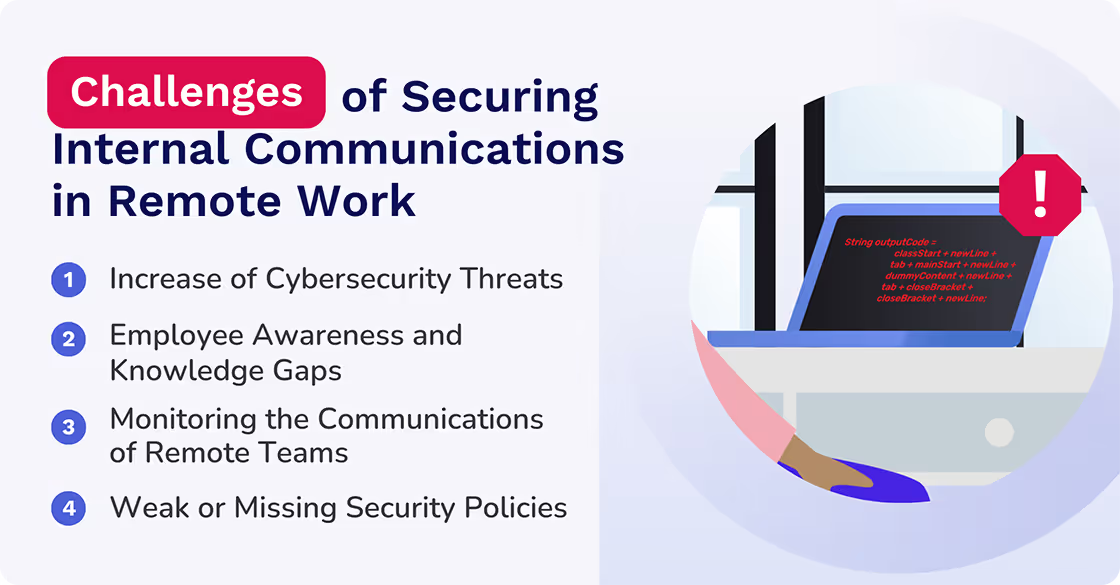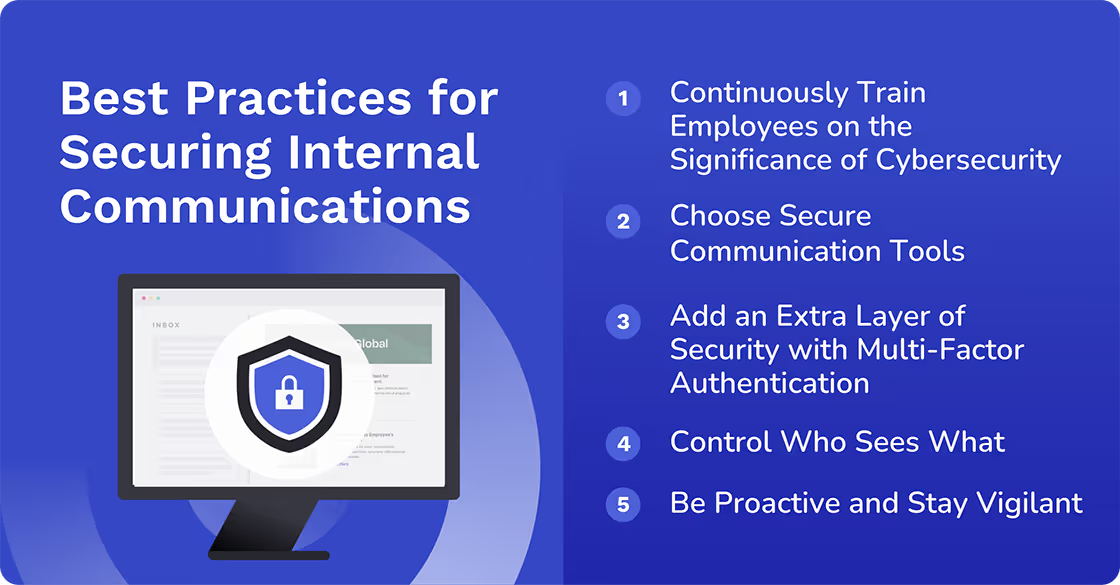Securing Internal Communication in a Remote Work Environment
Learn how to secure internal communication in a remote work environment. From cybersecurity to employee training, safeguard your organization’s sensitive data.


Choose the right Internal Communication Software
Choosing the right internal communications software is a delicate process. Evaluate yourcommunication goals and needs, and select the right software with confidence using our Internal Communication Software Buyer’s Guide.
Access NowThe concept of working from home used to be a dream. Who would have thought that the time would come when millions of employees would work from the comfort of their rooms and avoid the commuting stress?
Even though remote work has many benefits such as enhanced productivity and reduction of costs, it has its downsides. One of such challenges is internal communication. Organizations are concerned about closing the physical distance as well as enhancing secure internal communication in remote work environments.
According to the Pew Research Center, about 14% or 22 million employees in the United States work from home. They represent 35% of those who have jobs that can be done from home. Therefore, the challenge of securing communication in a remote work environment cannot be regarded as insignificant. It is vital!
In this blog post, we will explore challenges and best practices for securing internal communication in remote work environments. It’s the only way to effectively safeguard your organization’s sensitive data.
Evaluate Your Internal Communication Channels
Before deciding on the best ways of securing internal communication, you need to evaluate your communication channels to assess whether they can handle the required task.
Here are five questions you need to answer.
#1 Are you reaching everyone?
Remote work environments can reveal limitations in your communication channels. For example, all your employees may not have the same hardware and software at home, which may cause connectivity issues. Because of this, you might find it difficult to reach some workers when you need them most.
If this is an issue, consider investing in secure equipment for your full time, remote employees. Many companies prefer to do this, with good reason.
#2 Are your messages delivered at the right time?
Work schedules are no longer as rigid as they were in the past for most employees. This makes message timing even more important.
Information must be communicated to everybody, regardless of the organization's geographical location, department, or status. An effective channel provides equal and timely communication to all the stakeholders in the organization by passing the same information at the same time. Furthermore, real-time communication is crucial in a remote work structure, and technology should facilitate and not impose barriers to your communication.
Either way, an omnichannel platform will ensure a seamless, integrated approach.
#3 Are you keeping your team engaged?
Is your internal communication system engaging? Ideally, it should offer a steady and highly informative feed and content that could contribute to team interactions.
The best platforms are those that facilitate participation by presenting opportunities for interaction. The risk of disengagement increases for remote employees. Therefore, you are responsible for making them feel wanted and involved in the team.
4# Are you listening?
There is sometimes a tendency to focus more on urgent changes and policies than on two-way communication channels. Whether employees are working remotely or on site, feedback is critically important.
Not prioritizing feedback is a particularly severe mistake when dealing with remote employees and teams. Now, more than ever, it is crucial to listen to your employees, get their feedback, and act on it.
#5 Are you tracking your communication effectiveness?
Just as important as feedback, tracking internal communication metrics is crucial for the evaluation of any channel. The results will help you assess the level of engagement and adjust your strategy where necessary.
Employee apps also provide a dashboard for viewing the level of interaction between the teams and departments, along with reports for more detailed statistics. Don't rely on guesswork.
If you are concerned about the effectiveness of your current channel, an internal communication platform like Cerkl Broadcast can be a game-changer for communication in a remote work environment.
Challenges of Securing Internal Communication in Remote Work
By answering these five questions, you can assess whether your internal communication channels are effective or not. But that's not all that matters. Are your internal channels secure?
While advantageous, the digital age also comes with serious challenges, especially regarding internal communication in remote work environments. Here are some key challenges you might be facing.
Cybersecurity Threats on the Rise
While certain security measures can be beneficial and improve protection, they are not infallible. The frequency of cyberattacks, including malware, phishing scams, and ransomware, continues to rise daily.
Phishing attacks are very popular. A single click on a dangerous link can compromise your entire communication system. These threats can tamper with the communication process and expose confidential information. Similarly, malware attacks are quite dangerous. According to CleanMyMac's post, malware can slow down even the fastest systems like MacBooks, which results in reduced remote employees' productivity.
Employee Knowledge Gaps
Employees may sometimes be careless and pass sensitive information through unsecured means. For instance, an employee working from home might use an informal chat application to discuss a sensitive matter with another employee, ignorant of the consequences of such an action.
That lack of awareness can put your organization at risk for social engineering, where a cybercriminal simply tricks the employee into giving up confidential data or information.
Monitoring Remote Teams
As the number of remote employees in your organization increases, it can become challenging to supervise their communication and guarantee that they use secure platforms. This decentralized work environment can make it difficult, even daunting, to ensure secure communication practices.
Missing Security Policies
Most organizations have weak security policies that highlight measures of access control, and the use of personal devices. They also make securing internal communications in remote work environments virtually impossible.
Without a clear policy, employees might not be aware of the best practices for securing internal communication, leaving your organization vulnerable to cyber-attacks.

Best Practices for Securing Internal Communication
Now that we’ve discussed the challenges of internal communications, let’s explore ways to safeguard your internal communication and protect sensitive information. Here are some strategies you should implement.
Train Your Team
Knowledge is power. Continuously train your employees on the significance of cybersecurity and how they can avoid the corresponding threats. This includes training them not to pass any messages or files through other channels other than the official ones. To make these sessions more engaging and effective, consider using the AI presentation makers.
Choose Secure Communication Tools
It makes sense to use a secure internal communications platform like Cerkl Broadcast that streamlines time-sensitive internal comms. Ensure the platform you opt for has key features like data encryption and offers security measures for sensitive data. This is essential for securing internal communication in a remote work environment.
Additionally, it’s best to use a Virtual Private Network (VPN) as it adds an extra layer of security by encrypting internet connections and protecting data in transit. There is a lot to choose from and many VPN providers offer free trials, allowing you to test their features before committing to a plan.
Layer Up Your Security
It is sensible to add an extra layer of security. For instance, it is advisable to use Multi-Factor Authentication (MFA) for your communication platform. MFA makes it necessary for a user to enter their second authentication factor, such as a cell phone code, to sign in, minimizing attack.
Also, it makes sense to limit the storage of sensitive information on workers’ devices like laptops and mobile phones. These devices may be lost, stolen or compromised, so it's best to limit the possible damage.
Control Who Sees What
Employ strict access controls to restrict the exposure and access of personnel who do not need to be privy to sensitive conversations and discussions. This way, the confidential data can be accessed only by those employees who need it to perform their roles in your company, further securing internal communication.
Stay Vigilant
Don't get complacent! It should become a normal practice to go through your firm’s internal communication platforms to identify those likely to be compromised. Be proactive. Observe new technology innovations and ensure your communication tools are always compatible with the current security updates.

What's Next?
Cerkl Broadcast was built with enterprise security and compliance uppermost in developers’ minds. It is designed to keep content and users safe. This means that you can ensure secure internal communication for remote work environments. This will enhance collaboration and keep confidential information safe.
FAQ
What is internal communication within an organization? Internal communication refers to the flow of information within a company. It includes ways employees pass information to one another. It can take the form of a company announcement, training handouts, other forms of documentation, internal magazines, and social media accounts.
Internal communication is important because it helps ensure that employees are up to date, everyone is on the same page, and working towards achieving the organizational objectives.
Why is secure internal communication crucial in a remote work environment? When organizations have remote staff, the workers are located geographically apart and can only communicate through electronic devices. This digital reliance creates new security risks.
Insecure communication channels potentially expose confidential information to hackers, phishing scams, and data leakage. These breaches can reveal confidential information and damage your reputation.
How can an organization ensure a secure internal communication connection? Organizations can take several steps to ensure secure internal communication. They need to prioritize employee education. Training employees on how to avoid exposure to phishing scams and the best practices for data security is a great start.
They should put a secure internal communication channel strictly for work purposes in place. Also, it's best to implement multi-factor authentication to enhance security.








.avif)

